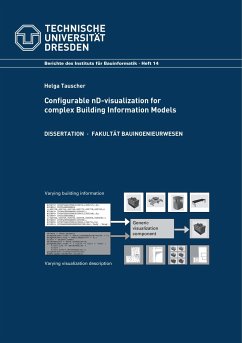With the ongoing development of building information modelling (BIM) towards a comprehensive coverage of all construction project information in a semantically explicit way, visual representations became decoupled from the building information models. While traditional construction drawings implicitly contained the visual representation besides the information, nowadays they are generated on the fly, hard-coded in software applications dedicated to other tasks such as analysis, simulation, structural design or communication.
Due to the abstract nature of information models and the increasing amount of digital information captured during construction projects, visual representations are essential for humans in order to access the information, to understand it, and to engage with it. At the same time digital media open up the new field of interactive visualizations. The full potential of BIM can only be unlocked with customized task-specific visualizations, with engineers and architects actively involved in the design and development process of these visualizations. The visualizations must be reusable and reliably reproducible during communication processes. Further, to support creative problem solving, it must be possible to modify and refine them.
This thesis aims at reconnecting building information models and their visual representations: on a theoretic level, on the level of methods and in terms of tool support.
Due to the abstract nature of information models and the increasing amount of digital information captured during construction projects, visual representations are essential for humans in order to access the information, to understand it, and to engage with it. At the same time digital media open up the new field of interactive visualizations. The full potential of BIM can only be unlocked with customized task-specific visualizations, with engineers and architects actively involved in the design and development process of these visualizations. The visualizations must be reusable and reliably reproducible during communication processes. Further, to support creative problem solving, it must be possible to modify and refine them.
This thesis aims at reconnecting building information models and their visual representations: on a theoretic level, on the level of methods and in terms of tool support.







